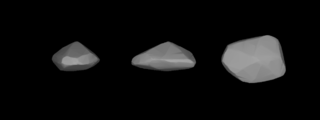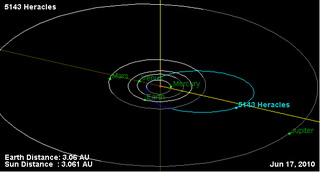1509 Esclangona, provisional designation 1938 YG, is a rare-type Hungaria asteroid and binary system from the inner regions of the asteroid belt, approximately 8 kilometers in diameter. It is named after French astronomer Ernest Esclangon.

Taurinensis, provisional designation 1903 LV, is a stony asteroid and large Mars-crosser on an eccentric orbit from the inner regions of the asteroid belt, approximately 20 kilometers in diameter. It was discovered on 23 June 1903, by astronomer Max Wolf at the Heidelberg-Königstuhl State Observatory in southwest Germany. The asteroid was named after the Italian city of Turin. It is the 4th-largest Mars-crossing asteroid.
1065 Amundsenia, provisional designation 1926 PD, is a stony asteroid and sizeable Mars-crosser on an eccentric orbit from the inner asteroid belt, approximately 10 kilometers in diameter. It was discovered on 4 August 1926, by Soviet astronomer Sergey Belyavsky at the Simeiz Observatory on the Crimean peninsula. The asteroid was named after Norwegian polar explorer Roald Amundsen.
1717 Arlon, provisional designation 1954 AC, is a binary Florian asteroid from the inner regions of the asteroid belt, approximately 8.5 kilometers in diameter.
6084 Bascom, provisional designation 1985 CT, is a binary Phocaea asteroid from the inner regions of the asteroid belt, approximately 6.3 kilometers in diameter. It was discovered on 12 February 1985, by American astronomer couple Carolyn and Eugene Shoemaker at Palomar Observatory in California. It is named after American geologist Florence Bascom. Its satellite measures approximately 2.3 kilometers and has an orbital period of 43.51 hours.

1338 Duponta, provisional designation 1934 XA, is a stony Florian asteroid and synchronous binary system from the inner regions of the asteroid belt, approximately 7.8 kilometers in diameter.
1453 Fennia, provisional designation 1938 ED1, is a stony Hungaria asteroid and synchronous binary system from the innermost regions of the asteroid belt, approximately 7 kilometers in diameter. Discovered by Yrjö Väisälä at the Turku Observatory in 1938, the asteroid was later named after the Nordic country of Finland. The system's minor-planet moon was discovered in 2007. It has a derived diameter of 1.95 kilometers and is orbiting its primary every 23.55 hours.
7369 Gavrilin, provisional designation 1975 AN, is a stony Phocaean asteroid, sizable Mars-crosser, and binary system on an eccentric orbit from the inner regions of the asteroid belt, approximately 5.5 kilometers in diameter. It was discovered on 13 January 1975, by Russian astronomer Tamara Smirnova at the Crimean Astrophysical Observatory in Nauchnyj, on the Crimean peninsula. The assumed S-type asteroid has a long rotation period of 49.1 hours. It was named after Russian composer Valery Gavrilin. The discovery of its 2.4-kilometer sized minor-planet moon was announced in October 2008.

5143 Heracles, provisional designation 1991 VL, is a highly eccentric, rare-type asteroid and synchronous binary system, classified as near-Earth object of the Apollo group, approximately 4.8 kilometers in diameter. The asteroid was discovered on 7 November 1991, by American astronomer Carolyn Shoemaker at Palomar Observatory in California, United States. It is named for the Greek divine hero Heracles. It has an Earth minimum orbit intersection distance of 0.058 AU (8.7 million km) and is associated with the Beta Taurids daytime meteor shower.
7088 Ishtar, provisional designation 1992 AA, is a synchronous binary asteroid and near-Earth object from the Amor group, approximately 1.3 kilometers in diameter. It was discovered on 1 January 1992, by American astronomer Carolyn Shoemaker at the Palomar Observatory in California. The relatively bright asteroid with an unknown spectral type has a rotation period of 2.7 hours. In December 2005, a 330-meter sized satellite was discovered, orbiting its primary every 20.65 hours.
8116 Jeanperrin, provisional designation 1996 HA15, is a Florian asteroid and synchronous binary system from the inner regions of the asteroid belt, approximately 4.8 kilometers (3 miles) in diameter. It was discovered on 17 April 1996, by Belgian astronomer Eric Elst at the La Silla Observatory in northern Chile. The likely stony S-type asteroid has a rotation period of 3.62 hours and a nearly round shape. It was named for French physicist and Nobel laureate Jean Baptiste Perrin. A minor-planet moon, a third the size of its primary, was discovered in 2007.
4082 Swann, provisional designation 1984 SW3, is a carbonaceous asteroid from the inner regions of the asteroid belt, approximately 10 kilometers in diameter.
4786 Tatianina, provisional designation 1985 PE2, is a bright background asteroid and synchronous binary system from the inner regions of the asteroid belt, approximately 3.4 kilometers (2.1 miles) in diameter. It was discovered on 13 August 1985, by Soviet astronomer Nikolai Chernykh at the Crimean Astrophysical Observatory in Nauchnij, on the Crimean peninsula. It was named after Tatiana Somova, a friend of the discoverer. The E-/Xc-subtype has a short rotation period of 2.9 hours. Its sub-kilometer minor-planet moon was discovered on 20 March 2006 and announced the following month.
2478 Tokai, provisionally designated 1981 JC, is a stony Florian asteroid and binary system from the inner regions of the asteroid belt, approximately 10 kilometers in diameter. It was discovered on 4 May 1981, by Japanese astronomer Toshimasa Furuta at Tōkai Observatory, Japan. The asteroid was named after the city of Tōkai.
3682 Welther, provisional designation A923 NB, is a background asteroid from the central regions of the asteroid belt, approximately 19 kilometers in diameter. It was discovered on 12 July 1923, by German astronomer Karl Reinmuth at the Heidelberg Observatory in southwest Germany. The asteroid has a rotation period of 3.6 hours. It was named after Barbara Welther, an American historian of science at CfA.
4142 Dersu-Uzala, provisional designation 1981 KE, is a Hungaria asteroid, sizable Mars-crosser and potentially slow rotator from the innermost region of the asteroid belt, approximately 6 kilometers in diameter. It was discovered by Czech astronomer Zdeňka Vávrová at Kleť Observatory on 28 May 1981. The rare A-type asteroid has a rotation period of 140 hours. It was named after the Siberian trapper and hunter Dersu Uzala.
5477 Holmes, provisional designation 1989 UH2, is a Hungaria asteroid and binary system from the innermost regions of the asteroid belt, approximately 3 kilometers (2 miles) in diameter. It was discovered on 27 October 1989, by American astronomer Eleanor Helin at the Palomar Observatory in California. The presumed E-type asteroid is likely spherical in shape and has a short rotation period of 2.99 hours. It was named for American amateur astronomer Robert Holmes. The discovery of its 1-kilometer-sized minor-planet moon was announced in November 2005.
(31345) 1998 PG is an eccentric, stony asteroid and binary system, classified as near-Earth object of the Amor group of asteroids, approximately 900 meters in diameter. It minor-planet moon, S/2001 (31345) 1, has an estimated diameter of 270 meters.
21088 Chelyabinsk, provisional designation 1992 BL2, is a stony asteroid and near-Earth object of the Amor group, approximately 4 kilometers in diameter. It was discovered on 30 January 1992, by Belgian astronomer Eric Elst at ESO's La Silla Observatory in northern Chile. The asteroid was named after the Russian city of Chelyabinsk and for its spectacular Chelyabinsk meteor event in 2013.
(15700) 1987 QD, provisional designation 1987 QD, is a Mars-crossing asteroid and a binary candidate from inside the innermost region of the asteroid belt, approximately 3 kilometers in diameter. It was discovered on 24 August 1987, by American astronomer Stephen Singer-Brewster at the Palomar Observatory in California. The likely spherical X-type asteroid has a rotation period of 3.1 hours. The suspected presence of a kilometer-sized minor-planet moon was announced in November 2000.



